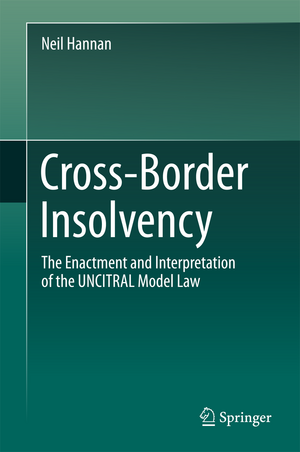Cross-Border Insolvency: The Enactment and Interpretation of the UNCITRAL Model Law
Autor Neil Hannanen Limba Engleză Hardback – 7 sep 2017
The book examines how the UNCITRAL Guide to enactment of the Model Law has affected the interpretation of each of its articles and, in turn, the courts’ ability to interpret and hence give effect to the purposes of the Model Law. It also considers the ability of courts to refer to amendments made to the Guide after enactment of the Model Law in a state, thereby questioning whether the current inconsistencies in interpretation can be overcome by UNCITRAL amending the Guide.
| Toate formatele și edițiile | Preț | Express |
|---|---|---|
| Paperback (1) | 696.18 lei 6-8 săpt. | |
| Springer Nature Singapore – 11 dec 2018 | 696.18 lei 6-8 săpt. | |
| Hardback (1) | 950.03 lei 6-8 săpt. | |
| Springer Nature Singapore – 7 sep 2017 | 950.03 lei 6-8 săpt. |
Preț: 950.03 lei
Preț vechi: 1158.57 lei
-18% Nou
Puncte Express: 1425
Preț estimativ în valută:
181.79€ • 190.67$ • 151.34£
181.79€ • 190.67$ • 151.34£
Carte tipărită la comandă
Livrare economică 01-15 aprilie
Preluare comenzi: 021 569.72.76
Specificații
ISBN-13: 9789811058752
ISBN-10: 981105875X
Pagini: 270
Ilustrații: XII, 270 p.
Dimensiuni: 155 x 235 mm
Greutate: 0.58 kg
Ediția:1st ed. 2017
Editura: Springer Nature Singapore
Colecția Springer
Locul publicării:Singapore, Singapore
ISBN-10: 981105875X
Pagini: 270
Ilustrații: XII, 270 p.
Dimensiuni: 155 x 235 mm
Greutate: 0.58 kg
Ediția:1st ed. 2017
Editura: Springer Nature Singapore
Colecția Springer
Locul publicării:Singapore, Singapore
Cuprins
Chapter 1: Introduction.- Chapter 2: Development of the Model Law.- Chapter 3: Manner of Introduction of the Model Law.- Chapter 4: How does the Model Law affect existing principles of recognition?.- Chapter 5: Comparative Analysis of the Enactment and Interpretation of the Preamble and Chapter I of the Model Law on Cross-Border Insolvency - General Provisions.- Chapter 6: Comparative Analysis of the Enactment and Interpretation of the Chapter II of the Model Law on Cross-Border Insolvency - Access of Foreign Representatives and Creditors to Courts in this State.- Chapter 7: Comparative Analysis of the Enactment and Interpretation of Chapter III of the Model Law on Cross-Border Insolvency – Recognition of Foreign Proceeding and Relief.- Chapter 8: Comparative Analysis of the Enactment and Interpretation of Chapter IV of the Model Law on Cross-Border Insolvency – Cooperation with Foreign Courts and Foreign Representatives.- Chapter 9: Comparative Analysis of the Enactment and Interpretation of Chapter V of the Model Law on Cross-Border Insolvency - Concurrent Proceedings.- Chapter 10: Conflict of Laws.- Chapter 11: Centre of Main Interest and Establishment.- Chapter 12: Applicability of Rules of Private International Law.- Chapter 13: Interrelationship between the Model Law and the EC Regulation.- Chapter 14: Current Proposals which may affect the Model Law.- Chapter 15: Conclusions.
Notă biografică
Neil Hannan is a partner at Thomson Geer in Melbourne, Australia, whose area of practice is insolvency, specifically cross-border insolvencies. His experience includes commercial litigation, banking and finance, insurance, insolvency, directors’ and officers’ claims, and claims under the Competition and Consumer Act and the Corporations Act. He regularly appears in the Supreme and Federal Courts and on behalf of clients, including leading financial institutions, accountants, and corporate entities operating in both local and international markets.
Textul de pe ultima copertă
This book examines the effect of the adoption of the United Nations Committee on International Trade Law (UNCITRAL) Model Law on Cross-Border Insolvency in five common law jurisdictions, namely Australia, Canada, New Zealand, the United Kingdom, and the United States of America. It examines how each of those states has adopted, interpreted and applied the provisions of the Model Law, and highlights the effects of inconsistencies by examining jurisprudence in each of these countries, specifically how the Model Law affects existing principles of recognition of insolvency proceedings.
The book examines how the UNCITRAL Guide to enactment of the Model Law has affected the interpretation of each of its articles and, in turn, the courts’ ability to interpret and hence give effect to the purposes of the Model Law. It also considers the ability of courts to refer to amendments made to the Guide after enactment of the Model Law in a state, thereby questioning whether the current inconsistencies in interpretation can be overcome by UNCITRAL amending the Guide.
The book examines how the UNCITRAL Guide to enactment of the Model Law has affected the interpretation of each of its articles and, in turn, the courts’ ability to interpret and hence give effect to the purposes of the Model Law. It also considers the ability of courts to refer to amendments made to the Guide after enactment of the Model Law in a state, thereby questioning whether the current inconsistencies in interpretation can be overcome by UNCITRAL amending the Guide.
Caracteristici
Studies how the UNCITRAL Model Law on Cross-Border Insolvency has been introduced in Australia, Canada, New Zealand, the UK, and the USA, and the variations made by each state in enacting legislation Compares how the courts have interpreted the UNCITRAL Model Law on an article-by-article basis Considers possible reasons for inconsistencies in the interpretation of the provisions of the Model Law Includes supplementary material: sn.pub/extras
